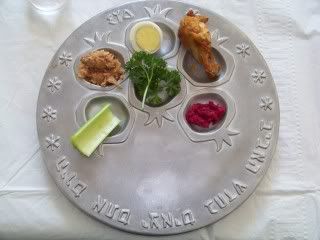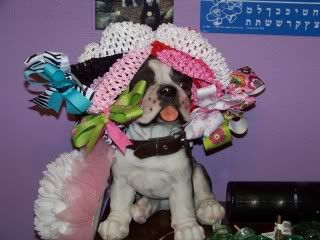
A tradition seder plate to help in remember the time where the Jewish people escaped from Egypt - every item on this place has a special meaning.
- Maror — Bitter herbs, symbolizing the bitterness and harshness of the slavery which the Jews endured in Egypt. Either horseradish or romaine lettuce may be eaten in fulfillment of the mitzvah of eating bitter herbs during the Seder.
- Charoset— A sweet, brown mixture representing the mortar used by the Jewish slaves to build the storehouses of Egypt. In Ashkenazi Jewish homes, charoset is traditionally made from chopped nuts, grated apples, cinnamon, and sweet red wine. Sephardi recipes call for dates and honey in addition to chopped nuts, cinnamon, and wine.
- Karpas — A vegetable other than bitter herbs, which is dipped into salt water at the beginning of the Seder. Parsley, celery or boiled potato is usually used. The dipping of a simple vegetable into salt water (which represents tears) mirrors the pain felt by the Jewish slaves in Egypt. Usually in a Shabbat or holiday meal, the first thing to be eaten after the kiddush over wine is bread. At the Seder table, however, the first thing to be eaten after the kiddush is a vegetable. This leads immediately to the recital of the famous question, Ma Nishtana — "Why is this night different from all other nights?"
- Z'roa — A roasted lamb or goat shankbone, chicken wing, or chicken neck; symbolizing the korban Pesach (Pesach sacrifice), which was a lamb that was offered in the Temple in Jerusalem then roasted and eaten as part of the meal on Seder night. Since the destruction of the Temple, the z'roa serves as a visual reminder of the Pesach sacrifice; it is not eaten or handled during the Seder. Vegetarians often substitute a beet quoting Pesachim 114b as justification.
- Beitzah — A hard-boiled egg, symbolizing the korban chagigah (festival sacrifice) that was offered in the Temple in Jerusalem and roasted and eaten as part of the meal on Seder night. Although both the Pesach sacrifice and the chagigah were meat offerings, the chagigah is commemorated by an egg, a symbol of mourning (as eggs are the first thing served to mourners after a funeral), evoking the idea of mourning over the destruction of the Temple and our inability to offer any kind of sacrifices in honor of the Pesach holiday. Since the destruction of the Temple, the beitzah serves as a visual reminder of the chagigah; it is not used during the formal part of the seder, but some people eat it with saltwater as the first course of the meal.

Stella's bow collection hanging on the statue of Alex --- Lauren and her mom went crazy with these things, but they are hellaciously cute :)
March 30, 2010

Stella's new colorful kangaroo friend, lol.
I love the sedar plate and its place for everything.
ReplyDeleteI also love the kangaroo!
I love those stuffed animals! They are from a co. called Allen Ave Designs....so fun =)
ReplyDelete